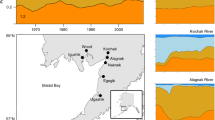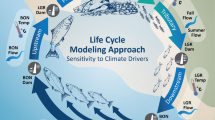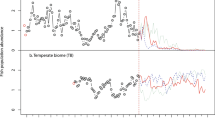Abstract
Global climate change is shifting the timing of life-cycle events, sometimes resulting in phenological mismatches between predators and prey. Phenological shifts and subsequent mismatches may be consistent across populations, or they could vary unpredictably across populations within the same species. For anadromous Pacific salmon (Oncorhynchus spp.), juveniles from thousands of locally adapted populations migrate from diverse freshwater habitats to the Pacific Ocean every year. Both the timing of freshwater migration and ocean arrival, relative to nearshore prey (phenological match/mismatch), can control marine survival and population dynamics. Here we examined phenological change of 66 populations across six anadromous Pacific salmon species throughout their range in western North America with the longest time series spanning 1951–2019. We show that different salmon species have different rates of phenological change but that there was substantial within-species variation that was not correlated with changing environmental conditions or geographic patterns. Moreover, outmigration phenologies have not tracked shifts in the timing of marine primary productivity, potentially increasing the frequency of future phenological mismatches. Understanding population responses to mismatches with prey are an important part of characterizing overall population-specific climate vulnerability.
This is a preview of subscription content, access via your institution
Access options
Access Nature and 54 other Nature Portfolio journals
Get Nature+, our best-value online-access subscription
$29.99 / 30 days
cancel any time
Subscribe to this journal
Receive 12 digital issues and online access to articles
$119.00 per year
only $9.92 per issue
Buy this article
- Purchase on Springer Link
- Instant access to full article PDF
Prices may be subject to local taxes which are calculated during checkout




Similar content being viewed by others
Data availability
Data are available on Dryad (https://doi.org/10.5061/dryad.dfn2z356g). Data provided are calculated peak-change and peak-range data. Source data are provided with this paper.
Code availability
Model code is available as an R package ‘phenomix’ by Eric Ward on Github at ‘ericward-noaa/phenomix’.
References
Parmesan, C. & Yohe, G. A globally coherent fingerprint of climate change impacts across natural systems. Nature 421, 37–42 (2003).
Root, T. L. et al. Fingerprints of global warming on wild animals and plants. Nature 421, 57–60 (2003).
Kovach, R. P., Joyce, J. E., Echave, J. D., Lindberg, M. S. & Tallmon, D. A. Earlier migration timing, decreasing phenotypic variation, and biocomplexity in multiple salmonid species. PLoS ONE 8, e53807 (2013).
Winder, M. & Schindler, D. E. Climatic effects on the phenology of lake processes. Glob. Change Biol. 10, 1844–1856 (2004).
Adrian, R., Wilhelm, S. & Gerten, D. Life-history traits of lake plankton species may govern their phenological response to climate warming. Glob. Change Biol. 12, 652–661 (2006).
Thackeray, S. J. et al. Trophic level asynchrony in rates of phenological change for marine, freshwater and terrestrial environments. Glob. Change Biol. 16, 3304–3313 (2010).
Edwards, M. & Richardson, A. J. Impact of climate change on marine pelagic phenology and trophic mismatch. Nature 430, 881–883 (2004).
Roslin, T. et al. Phenological shifts of abiotic events, producers and consumers across a continent. Nat. Clim. Change 11, 241–248 (2021).
Kharouba, H. M. et al. Global shifts in the phenological synchrony of species interactions over recent decades. Proc. Natl Acad. Sci. USA 115, 5211–5216 (2018).
Cushing, D. H. Plankton production and the year-class strength in fish populations: an update of the match/mismatch hypothesis. Adv. Mar. Biol. 26, 250–293 (1990).
Visser, M. E., Holleman, L. J. M. & Gienapp, P. Shifts in caterpillar biomass phenology due to climate change and its impact on the breeding biology of an insectivorous bird. Oecologia 147, 164–172 (2006).
Visser, M. E. & Gienapp, P. Evolutionary and demographic consequences of phenological mismatches. Nat. Ecol. Evol. 3, 879–885 (2019).
Visser, M. E., Van Noordwijk, A. J., Tinbergen, J. M. & Lessells, C. M. Warmer springs lead to mistimed reproduction in great tits (Parus major). Proc. R. Soc. Lond. B 265, 1867–1870 (1998).
Primack, R. B. et al. Spatial and interspecific variability in phenological responses to warming temperatures. Biol. Conserv. 142, 2569–2577 (2009).
Elmqvist, T. et al. Response diversity, ecosystem change, and resilience. Front. Ecol. Environ. 1, 488–494 (2003).
Inouye, B. D., Ehrlén, J. & Underwood, N. Phenology as a process rather than an event: from individual reaction norms to community metrics. Ecol. Monogr. 89, e01352 (2019).
Chittenden, C. M. et al. Recent salmon declines: a result of lost feeding opportunities due to bad timing? PLoS ONE 5, e12423 (2010).
Satterthwaite, W. H. et al. Match–mismatch dynamics and the relationship between ocean-entry timing and relative ocean recoveries of Central Valley fall run Chinook salmon. Mar. Ecol. Prog. Ser. 511, 237–248 (2014).
Wilson, S. M., Buehrens, T., Fisher, J., Wilson, K. & Moore, J. W. Phenological mismatch, carryover effects, and marine survival in a wild steelhead trout Oncorhynchus mykiss population. Prog. Oceanogr. 193, 102533 (2021).
Carr-Harris, C. N. et al. Phenological diversity of salmon smolt migration timing within a large watershed. Trans. Am. Fish. Soc. 147, 775–790 (2018).
Eliason, E. J. et al. Differences in thermal tolerance among sockeye salmon populations. Science 332, 109–112 (2011).
Crozier, L. G., Scheuerell, M. D. & Zabel, R. W. Using time series analysis to characterize evolutionary and plastic responses to environmental change: a case study of a shift toward earlier migration date in sockeye salmon. Am. Nat. 178, 755–773 (2011).
Quinn, T. P. The Behaviour and Ecology of Pacific Salmon and Trout 2nd edn, 259–287 (Univ. Washington Press, 2018).
Poloczanska, E. S. et al. Global imprint of climate change on marine life. Nat. Clim. Change 3, 919–925 (2013).
Allen, S. E. & Wolfe, M. A. Hindcast of the timing of the spring phytoplankton bloom in the Strait of Georgia, 1968–2010. Prog. Oceanogr. 115, 6–13 (2013).
Malick, M. J., Cox, S. P., Mueter, F. J., Peterman, R. M. & Bradford, M. Linking phytoplankton phenology to salmon productivity along a north–south gradient in the Northeast Pacific Ocean. Can. J. Fish. Aquat. Sci. 72, 697–708 (2015).
Taylor, S. G. Climate warming causes phenological shift in Pink Salmon, Oncorhynchus gorbuscha, behavior at Auke Creek, Alaska: climate warming and pink salmon behavior. Glob. Change Biol. 14, 229–235 (2007).
Otero, J. et al. Basin-scale phenology and effects of climate variability on global timing of initial seaward migration of Atlantic salmon (Salmo salar). Glob. Change Biol. 20, 61–75 (2014).
Spence, B. C. & Hall, J. D. Spatiotemporal patterns in migration timing of coho salmon (Oncorhynchus kisutch) smolts in North America. Can. J. Fish. Aquat. Sci. 67, 1316–1334 (2010).
Spence, B. C., Dick, E. J. & Fleming, I. Geographic variation in environmental factors regulating outmigration timing of coho salmon (Oncorhynchus kisutch) smolts. Can. J. Fish. Aquat. Sci. 71, 56–69 (2014).
Ware, D. M. & Thomson, R. E. Bottom-up ecosystem trophic dynamics determine fish production in the Northeast Pacific. Science 308, 1280–1284 (2005).
Losee, J. P., Kendall, N. W. & Dufault, A. Changing salmon: an analysis of body mass, abundance, survival, and productivity trends across 45 years in Puget Sound. Fish. Fish. 20, 934–951 (2019).
Crozier, L. G. et al. Potential responses to climate change in organisms with complex life histories: evolution and plasticity in Pacific salmon: evolutionary responses to climate change in salmon. Evol. Appl. 1, 252–270 (2008).
McClure, M. M. et al. Evolutionary consequences of habitat loss for Pacific anadromous salmonids. Evol. Appl. 1, 300–318 (2008).
Sturrock, A. M. et al. Eight decades of hatchery salmon releases in the California Central Valley: factors influencing straying and resilience. Fisheries 44, 433–444 (2019).
Moore, J. W. & Schindler, D. E. Getting ahead of climate change for ecological adaptation and resilience. Science 376, 1421–1426 (2022).
Daly, E. A. et al. Juvenile steelhead distribution, migration, feeding, and growth in the Columbia River estuary, plume, and coastal waters. Mar. Coast. Fish. 6, 62–80 (2014).
Daly, E. A., Auth, T. D., Brodeur, R. D. & Peterson, W. T. Winter ichthyoplankton biomass as a predictor of early summer prey fields and survival of juvenile salmon in the northern California Current. Mar. Ecol. Prog. Ser. 484, 203–217 (2013).
Atlas, W. I. et al. Indigenous systems of management for culturally and ecologically resilient Pacific salmon (Oncorhynchus spp.) fisheries. BioScience 71, 186–204 (2021).
Schindler, D. E. & Hilborn, R. Prediction, precaution, and policy under global change. Science 347, 953–954 (2015).
Methot, R. D. & Wetzel, C. R. Stock synthesis: a biological and statistical framework for fish stock assessment and fishery management. Fish. Res. 142, 86–99 (2013).
Kristensen, K., Nielsen, A., Berg, C. W., Skaug, H. & Bell, B. TMB: Automatic differentiation and Laplace approximation. J. Stat. Softw. 70, 1–21 (2016).
R Core Team R: A Language and Environment for Statistical Computing (R Foundation for Statistical Computing, 2020).
Akaike, H. Information theory as an extension of the maximum likelihood principle. In Second International Symposium on Information Theory (eds Petrov, B. N. & Csaki, F.) 267–281 (Akademiai Kiado, 1973).
Caissie, D. The thermal regime of rivers: a review. Freshw. Biol. 51, 1389–1406 (2006).
Wang, T., Hamann, A., Spittlehouse, D. & Carroll, C. Locally downscaled and spatially customizable climate data for historical and future periods for North America. PLoS ONE 11, e0156720 (2016).
McLean, N., Lawson, C. R., Leech, D. I. & van de Pol, M. Predicting when climate-driven phenotypic change affects population dynamics. Ecol. Lett. 19, 595–608 (2016).
Waite, J. N. & Mueter, F. J. Spatial and temporal variability of chlorophyll-a concentrations in the coastal Gulf of Alaska, 1998–2011, using cloud-free reconstructions of SeaWiFS and MODIS-Aqua data. Prog. Oceanogr. 116, 179–192 (2013).
Kahru, M., Kudela, R., Anderson, C., Manzano-Sarabia, M. & Mitchell, B. Evaluation of satellite retrievals of ocean chlorophyll-a in the California current. Remote Sens. 6, 8524–8540 (2014).
Foukal, N. P. & Thomas, A. C. Biogeography and phenology of satellite-measured phytoplankton seasonality in the California current. Deep Sea Res. Part I 92, 11–25 (2014).
Acknowledgements
This project would not have been possible without the dedication and fortitude of scientists and technicians from Alaska Department of Fish and Game, Fisheries and Oceans Canada, Washington Department of Fish and Wildlife, Oregon Department of Fish and Wildlife, University of Washington, University of Oregon, Confederated Tribes of Warm Springs and the US Forest Service that collected the 41 long-term datasets used in this project. Please see the extended acknowledgement in the Supplementary Information for a detailed list of acknowledgements. We also thank the Chelan County Public Utility District, King County Cooperative Watershed Management grant programme, the WRIA 8 technical committee, Seattle Public Utilities, Puget Sound Energy, Bonneville Power Administration, Dingell–Johnson Sportfish Restoration Act, Washington State Salmon Recovery Funding Board, Washington State General Fund, Seattle City Light and Habitat Conservation Trust Foundation for supporting these monitoring projects. Funding for S.M.W. was provided by Vanier Canada Graduate Scholarship, Weston Family Scholarship and Steven Berkeley Marine Conservation Fellowship. Additional funding from the Liber Ero Foundation was for J.W.M. We also thank T. D. Williams, L. Crozier, A. Dufault, N. Dulvy, N. Mantua, J. Reynolds and members of the Salmon Watersheds Lab for feedback on the early paper.
Author information
Authors and Affiliations
Contributions
S.M.W. collated data and completed analysis. S.M.W. and J.W.M. designed the study and wrote the paper. E.J.W. developed models. S.M.W., J.W.M., E.J.W., C.W.K., J.H.A., T.W.B., C.N.C.-H., P.C.C., T.D.D., M.R.D., L.G., P.J.L., M.N.C.L., D.A.P., D.T.S., M.R.S., E.J.S., I.A.T. and G.J.W. contributed to data collection and writing.
Corresponding author
Ethics declarations
Competing interests
The authors declare no competing interests.
Peer review
Peer review information
Nature Ecology & Evolution thanks Andrea Reid, Xingli Giam and the other, anonymous, reviewer(s) for their contribution to the peer review of this work.
Additional information
Publisher’s note Springer Nature remains neutral with regard to jurisdictional claims in published maps and institutional affiliations.
Extended data
Extended Data Fig. 1 Rate of change in peak outmigration timing modelled with increasing numbers of sequential years of data.
Rate of change was calculated beginning with using only the five most recent years of outmigration data and re-running the analysis again for each successive year added. Thus, each point above represents a model run, beginning with five which included the most recent five years of data, and ending with the complete dataset. Species are represented by colours with coho (green), pink (pink), sockeye (vermillion), Chinook (black), chum (blue) and steelhead (orange). Vertical lines (error bars) represent 95% confidence interval, point represents mean. When models did not converge, confidence intervals were not produced. More information on sites is located in Supplementary Table 1.
Extended Data Fig. 2 Top model parameter estimates for shifts in peak outmigration phenology.
Top model parameter estimates (left) and the relationship between log trap elevation and change in peak phenology for Chinook salmon (right, top) and steelhead trout only (right, bottom). Left panel: black bars are parameters for which confidence intervals do not overlap with zero, indicating a significant effect; grey bars overlap zero and are not significant. Point is the mean, horizontal error bars represent the 95% confidence interval. Right panel: colours indicate the salmon species (coho = green, pink = pink, chum = blue, steelhead = orange, sockeye = vermillion, Chinook = black), grey background indicates 95% confidence region for relationship between log trap elevation and rate of change in peak outmigration timing. More information on sites is located in Supplementary Table 1.
Extended Data Fig. 3 Comparison of the rate of change in peak outmigration timing for salmon and spring phytoplankton phenology.
Rate of change in peak outmigration timing for salmon (coho (green), pink (pink), sockeye (vermillion), Chinook (black), chum (blue) salmon and steelhead (orange) trout) and spring phytoplankton phenology (dark green) between 1999 and 2019 (truncated salmon time series). Where curve (95% confidence interval) overlaps 0 (horizontal dashed line) species phenologies are not shifting. Overlap between spring phytoplankton phenology and salmon phenology curves indicates that they are shifting at the same rate.
Extended Data Fig. 4 Map of satellite derived chlorophyll-a 2 × 2 degree sections 1–29, with trap locations (black triangles).
Inset is the rate of change in initial peak of chlorophyll-a (first day above the 5% of the annual mean chlorophyll-a) time period spans from 1999–2019 (n = 20 for all sections). Points represent mean rate of change, horizontal error bars represent 95% confidence intervals.
Extended Data Fig. 5 Comparison of rate of change in peak migration timing for full vs. truncated time series.
Full time series includes all years when data were collected (closed circles), whereas truncated time series includes only smolt data collected from 1999–2019 (open circles). Colours indicate species where orange = steelhead trout, green = coho, black = Chinook, vermillion = sockeye, blue = chum, light pink = odd-year pink, dark pink = even year pink salmon. Ordered by difference in change of peak from negative to positive. More information on sites is located in Supplementary Table 1.
Supplementary information
Supplementary Information
Supplementary Table 1, Methods and Results for supporting analyses.
Source data
Source Data
Statistical source data for Figs. 1–4, Extended Data Figs. 1–5 and Extended Data Tables 1–4.
Rights and permissions
Springer Nature or its licensor (e.g. a society or other partner) holds exclusive rights to this article under a publishing agreement with the author(s) or other rightsholder(s); author self-archiving of the accepted manuscript version of this article is solely governed by the terms of such publishing agreement and applicable law.
About this article
Cite this article
Wilson, S.M., Moore, J.W., Ward, E.J. et al. Phenological shifts and mismatch with marine productivity vary among Pacific salmon species and populations. Nat Ecol Evol 7, 852–861 (2023). https://doi.org/10.1038/s41559-023-02057-1
Received:
Accepted:
Published:
Issue Date:
DOI: https://doi.org/10.1038/s41559-023-02057-1



